Title: The Three Young Nuclear Super Star Clusters in NGC 5253
Authors: Linda J. Smith, Varun Bajaj, Jenna Ryon, and Elena Sabbi
First Author’s Institution: Space Telescope Science Institute and European Space Agency, 3700 San Martin Drive, Baltimore, MD 21218
Status: Accepted to ApJ
It’s well observed that stars form in clumps, known as star clusters. Around 70% of all galaxies are observed to contain star clusters in their centre (or ‘nucleus’), known as nuclear star clusters (NSCs), but it is not clear how they actually came to be there. In addition to how nuclear star clusters actually form, a heavily debated question is where they form. The two mostly likely formation scenarios are either the formation of clusters elsewhere in the galaxy which migrate inwards, known as migration, or the in-situ formation of clusters in the centre triggered by infalling gas. This Astrobite gives an overview of these scenarios in more detail.
Today’s paper, almost inadvertently, contributes a really valuable piece of observational insight into the formation of nuclear star clusters.
Just like graduate students who enjoy leaving things to the last minute, star cluster formation thrives under high pressure. In environments such as in the nucleus (centre) of galaxies, pressures become high enough to form massive star clusters (>105M⊙), known as super star clusters (SSCs). These high pressures are further increased by other factors such as galaxy mergers or starbursts.
Today’s authors look at the compact dwarf galaxy NGC 5253, which is undergoing a very young central starburst, hosting a rich population of star clusters, including SSCs. The central starburst is likely triggered by an infalling stream of gas.
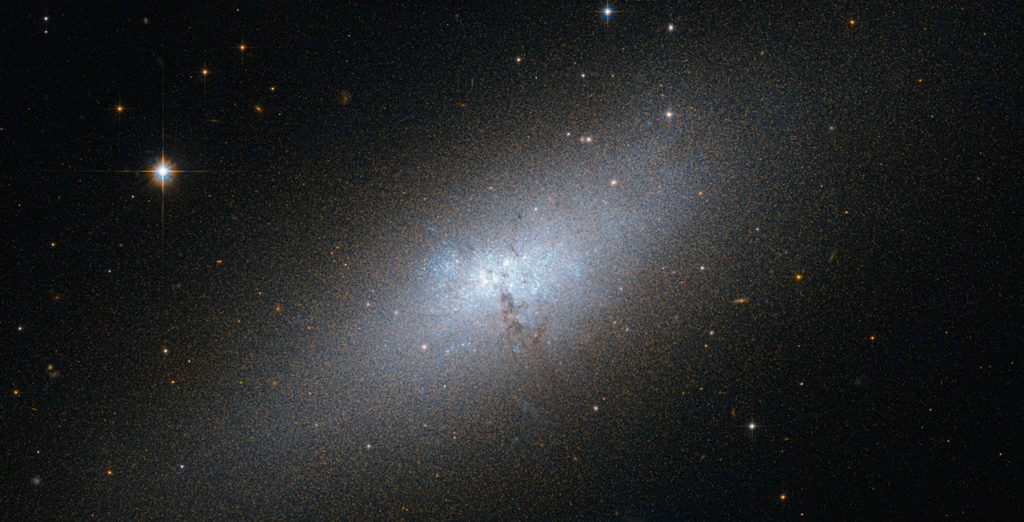
Credit: ESA/Hubble & NASA
Using multi-wavelength observations to paint the full picture
The centre of this galaxy is well studied from X-rays all the way to radio wavelengths. For the 20 years prior to this study, much work had already been done in observations of the radio, infrared and optical which is summarised below. First we’ll explore what each wavelength can tell us before summarising how today’s authors were able to use Gaia data to tie the whole picture together.
Radio
Radio observations done with ALMA found one dominant intense radio source from a region with a bright core termed the ‘supernebula’, as well as a secondary radio source just next to it. A number of dense, hot and high pressure clouds are also identified in the central ~100 parsecs (pc) starburst region and find that one of clouds is spatially coincident with this supernebula. The suggestion is that this cloud consists of hot molecular clumps or cores associated with the stars in the embedded supernebula cluster.
Infrared
Infrared (IR) observations using the NICMOS instrument on the Hubble Space Telescope (HST) identified a double central star cluster, that initially appeared to be coincident with the two main radio sources. However, further studies from 2017 showed that these two IR sources were not associated with the supernebula, deepening the mystery of what was going on within the centre of NGC 5253.
Optical
Optical wavelengths using the ACS instrument on HST identified the two extremely young clusters (also identified in the IR). They were also able to constrain values for the ages of just 1±1 Myr and masses of 7.5±0.3 × 104M⊙ and 2.5±0.6 × 105M⊙. They find that these two clusters are close to the radio sources mentioned earlier, but it’s difficult to tell due to the uncertainty in HST astrometry.
Piecing everything together
Matching the observations from the radio emission with the IR and optical wavelengths is extremely difficult due to the varying precision of these measurements. However, with the publication of Gaia Data Release 2, today’s authors were able to not only add new measurements, but accurately bring all previous observations together.
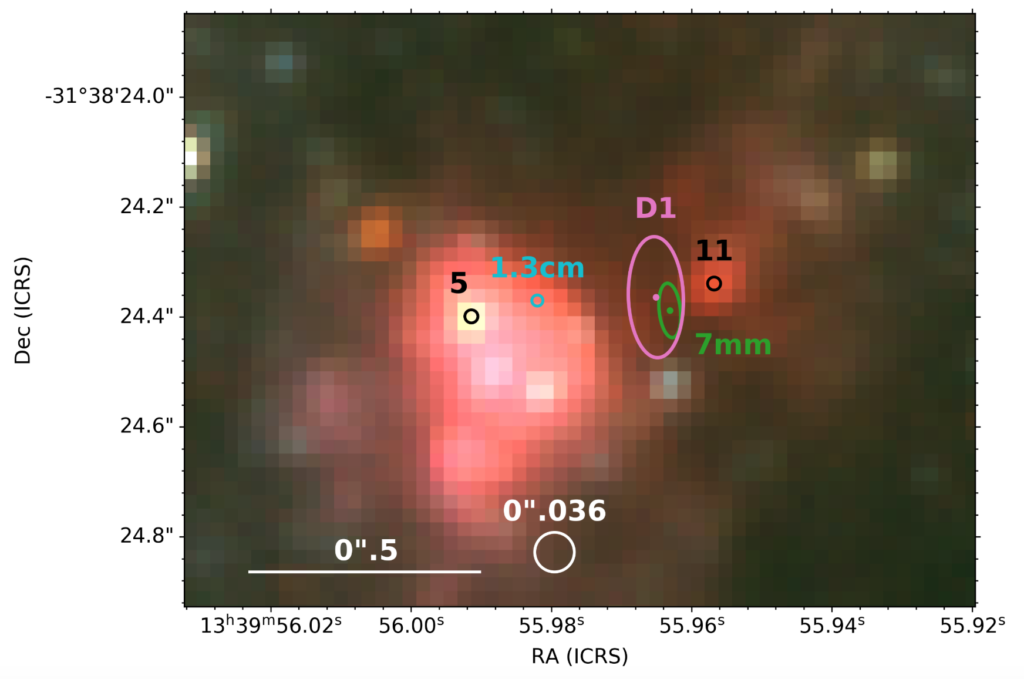
Figure 2 shows the result of remapping the previous measurements into a Gaia reference frame, accurately mapping where the emission in each wavelength is coming from. It was previously speculated that the supernebula and its associated hot molecular cloud was spatially coincident with the SSC-11, however from this remapping, we can see that this is not the case. In fact, neither of the radio sources are actually associated with the two central SSCs identified in the optical and IR. Instead, the radio sources are lying in a highly obscured region between the two clusters. The authors therefore conclude that in fact there are three SSCs in the centre of NGC 5253. This is further supported by looking at the system in the IR, shown in Figure 3.
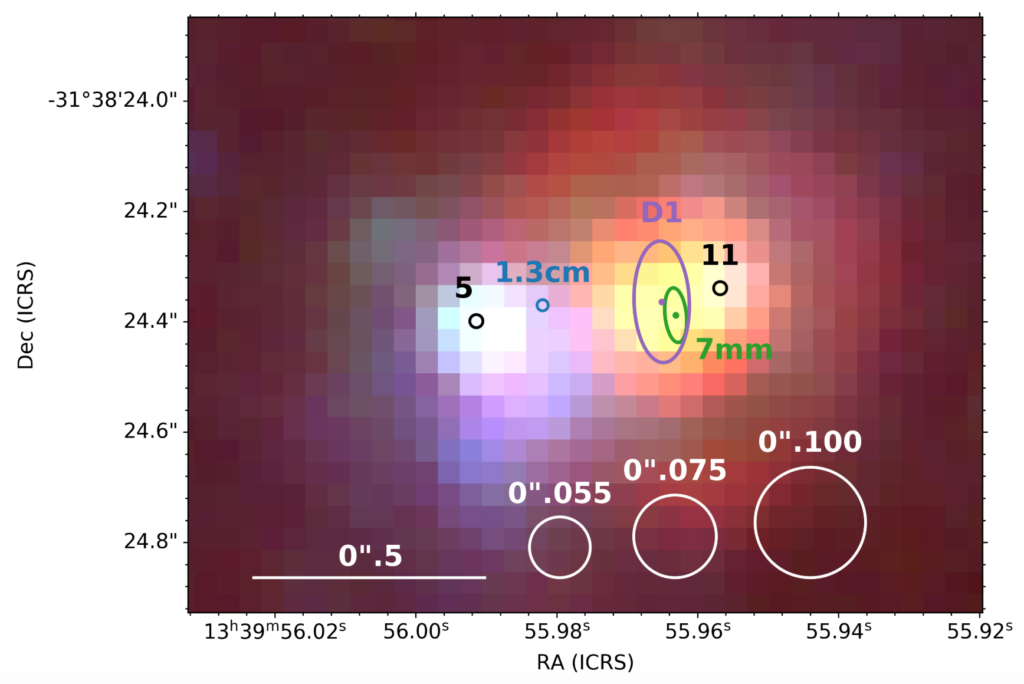
In Figure 3, we can see two main peaks in the IR emission. The peak on the left is very close to SSC-5, suggesting that this emission is indeed coming from this star cluster. However, the bright emission peak on the right seems to not be associated with SSC-11, but instead with an obscured SSC just to its left.
Going further into these measurements, the authors are not able to resolve the size of both SSC-5 and SSC-11, providing an upper limit on the size (half-light radius) of just 0.6 pc. With masses of over 104 M⊙, this is in agreement with the observed densities of other star clusters, which are the densest stellar systems in the Universe. They also find that the obscured SSC appears to be a twin of SSC-11 in terms of mass, however SSC-11 is older than its obscured companion. We can determine the age difference of the two SSCs due to the fact that SSC-11 is visible in the UV and optical, indicating that it has cleared much of its surrounding dust from which the cluster was born. The obscured SSC is not seen in the optical or UV due to the fact it is still embedded in its birth dust cloud. The dense dust cloud surrounding the cluster absorbs the UV and optical light emitted by the stars and reemits in the IR, resulting in the bright peak observed in Figure 3.
The fate of these star cluster siblings
One reason why the result from today’s paper is so enlightening, aside from being an impressive compilation of 20 years of observations, is the fact that this gives an intriguing insight into how nuclear star clusters are formed. Recalling the beginning of this Astrobite, there were two main formation scenarios: migration and in-situ formation. Today’s study clearly supports the in-situ scenario. Due to their very young ages, we know that the three SSCs have formed in the centre of the galaxy. As they are at the deepest part of the potential well of the galaxy, they will likely merge, forming a nuclear star cluster.
Nuclear Star Clusters and beyond
Finding galaxies such as NGC 5253 and achieving such high precision measurements over a wide range of wavelengths allows us to distinguish between these very subtle formation scenarios that were previously difficult to observe. In the hierarchical build up of galaxies, dwarf galaxies are the building blocks of massive galaxies. It’s suggested nuclear star clusters could potentially host intermediate mass black holes, which are thought to be the building blocks of supermassive black holes. By studying the components that build massive galaxies, we can construct a fuller understanding of galaxy formation.

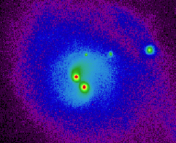
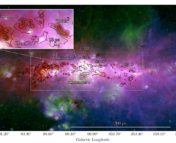
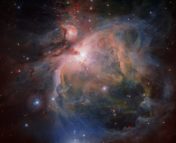

Gaia is the gift that keeps on giving!
What a crazily impressive piece of technology (and data massaging.)